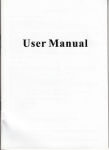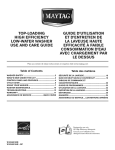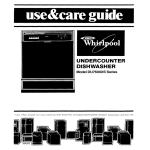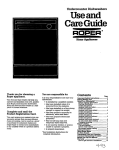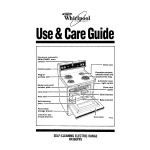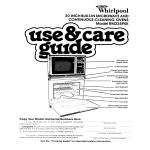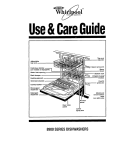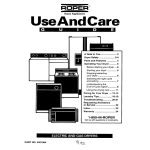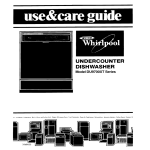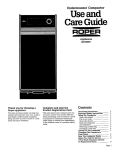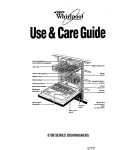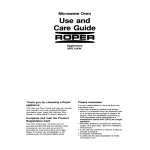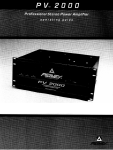Download Whirlpool WU1000XO User's Manual
Transcript
Undercounter Dishwasher Useand CareGuide Home Appliances wu1oooxo Thank you for choosing a Roper appliance. This Use and Care Guide will help you operate and mamtam your new, quahtybuilt Roper undercounter dishwasher Keep this Use and Care Guide m a safe place for future reference. Complete and mail the Product Registration Card. This card enters your warranty mto our warranty system that ensures efficient claim processing, can be used as a proof of purchase for Insurance claims and helps Roper to contact you immediately m the unlikely event of a product-safety recall. You are responsible for It is your responsibility to be sure your dishwasher 1 Is installed by a qualified installer 1 Has been installed where it is protected from the elements. 1 Has been installed on a floor strong enough to support its weight. . Has been properly connected to electricity, water and dram.* . Has been properly electrically grounded. * . Has had all hang tags and temporary labels removed. . Is not used by children or anyone unable to operate it properly. m Is properly maintained. x See Installation Instructions complete information. for Contents Page Important Safety Instructions Energy Saving Tips Using Your Dishwasher ~ Before starting dishwasher Starting dishwasher Cycle and options Proper Loading Top rack loading Bottom rack loadmg Silverware basket loading 2 2 3 3 3 3 4 4 4 4 5 Adding Detergent 5 Using Rinse Agent 6 For Best Results Dishwasher Care And Cleaning __ 6 Common Dishwashing Problems -7 11 Before You Call For Service 12 Warranty How to get service or assistance ~ 12 Important Safety Instructions To reduce the risk of fire, electrical shock, or injury when using your dishwasher, basic precautions including the following: 1. Read all instructions before using the dishwasher. 2. Properly connect to electricity and water. 3. DISHWASHER MUST BE ELECTRICALLY GROUNDED. Read the Installation Instructions for details. 4 Be sure your dishwasher is installed on a level floor that will hold the weight, and m an area suitable for its size and use. 5. When discarding an old dishwasher, always remove the door to prevent accidental entrapment or suffocation. 6. REMEMBER, use your dishwasher only for the job it was designed to do. 7. Store dishwasher detergent in a cool, dry place WHERE CHILDREN CAN’T REACH IT. 8. Use ONLY detergents and rinse agents recommended for use in a dishwasher. 9. Locate sharp items and knives so that they are not likely to damage door seal or cut the user. 10. DO NOT let children play in or on the dishwasher. 11. DO NOT reach mto the area below the bottom rack until the heating element has cooled for at least 20 minutes. 12. DO NOT wash plastic items unless marked “Dishwasher Safe” or the equivalent. If not marked, check manufacturer’s recommendations. 13. DO NOT use your dishwasher unless all enclosure panels are properly in place. follow 14. DO NOT sit on, stand on or abuse the dishwasher door or dish racks. 15. DO NOT tamper with controls. 16. If hot water has not been used recently (usually two weeks or longer), hydrogen gases may build up m the water heater and the hot water pipes. HYDROGEN GAS IS EXPLOSIVE. To prevent injury or damage, before using your dishwasher, turn on all hot water faucets and allow water to run for several minutes. This will allow gases to escape. Do not smoke or use any open flame near the faucet while it is open. 17. Disconnect electrical power to the dishwasher before attempting to service. SAVE THESE INSTRUCTIONS Energy Saving Tips You can help save energy if you 1. Wash full loads. Running a halffilled dishwasher uses the same amount of electricity and hot water as a fully loaded machine. 2. Air dry dishes when you don’t need a rapid dying cycle. Allow longer drying times (overnight). Use a rinse agent to improve drying. 3. Load correctly for best washing results. Incorrect loading may cause poor washmg and the need to rewash all or part of the load. Page 2 4 Do not pre-rinse normally soiled dishes. Select the correct cycle for the load and use the recommended amount of detergent for good washing results without hand rinsing. 5. Use your dishwasher during offpeak hours. Local utilities recommend this to avoid heavy usage of energy at certain times of day. 6 Kitchen cleanup can be done quickly and efficiently through the use of your dishwasher. Most appliance parts that can fit in the dishwasher can be cleaned by it. Burned-on soil, however, should be cleaned by hand. Using Your Dishwasher Before starting dishwasher Spray tower protector Silverware basket Bottom rack Filter system screen (not shown) II/ Water inlet opening Heating elemen Lower spray arm Overfill protector tergent dispenser - Access panel -Door color panel \ Rinse agent dispenser Cycle and options 1. Read “Important Safety Instructions” on page 2 before starting your dishwasher. 2. Properly load the top and bottom racks, and silverware basket. (See page 4.) 3. Spin the lower spray arm to make sure nothing will stop it from turning freely. 4. Add detergent. See page 5. 5. Check rinse agent dispenser. See page 5. 6. Push door firmly when closing and it will automatically latch. 7. Run hot water at sink nearest dishwasher until it is hot. Turn it off. Starting dishwasher 1. Select a drying option. 2. Turn the Cycle Control Knob clockwise to point to WASH. The dishwasher will automatically start the cycle. Model and serial number label (on right side) Option selector button Wash cycle Dry Select options A double wash for moderate to heavily soiled loads Select the mark next to WASH with the Cycle Control Knob. The cycle sequence will be: Wash p Rmse b Rinse b Wash b Rinse b Rinse p&me ~Dry Hoff If the HEATED DRYING Option Selector Button is pushed, air m the dishwasher IS heated during the “dry” part of the cycle. For best drying results, use a liquid rinse agent. Cycle control knob If the ENERGY SAVER Option Selector Button is pushed, air in the dishwasher is not heated. Using this option helps save energy, but dishes take longer to dry (overnight) and some water spottmg may result. Some items (such as plastics) may need towel drying. For best drying results, use a liquid rinse agent. Page 3 Proper Loading It is not necessary to rinse dishes before putting them mto the dishwasher. Just remove large pieces and quantities of food and bones. The filtering system helps keep food particles out of the wash water. Small particles are flushed away as water is pumped out. Larger particles are trapped on the filter screen system Refer to “Dishwasher care and cleaning” on page 6 for filter screen cleaning instructions. Always load dishes so soiled surfaces are reached by spray from rotating spray arm. Water must be able to dram off completely for best drying results. Be careful to separate items so spray can reach all surfaces. Top rack loading The top rack is designed for cups, glasses and smaller items. Cup and glass load 1 Place so open ends face down for cleaning and draining. 1 Load glasses in top rack only. Bottom rack is not designed for glasses. Damage may occur. Bottom rack loading Silverware Items with cooked-on or dried-on food should be loaded in the bottom rack with soiled surfaces facing inward to the spray. Load the silverware basket while in or out of the bottom rack. The loaded basket must be placed in the center front of the bottom rack for proper washing If the loaded silverware basket is placed in a different location some parts of the load may not be completely washed. Dish load 1 Place plates, soup bowls, etc., between prongs and facing the spray. 1 Do not place items directly over spray tower. basket loading Mixed load 1 Make sure pot handles and other items do not stop rotation of spray arm. Spray arm must move freely. 1 Load items so they do not block or cover the spray tower. 1 Securely place heavily soiled cookware face down in rack. Load forks and spoons so they don’t nest together. Spray can not reach nested items. Utensil load 1 Load cookie sheets, cake pans and other items at sides or back. Loading items in front may keep water spray from reaching detergent dispenser. NOTE: 1 Do not load items in the 1 When lower replace with 1 Place items in the rows between prongs. Placing them over the prongs can lead to breakage. 1 Be sure lightweight items are held firmly in place. . China, crystal and other delicate items must not touch each other during dishwasher operation. Damage may occur. Mixed load 1 Load plastic items only in the top rack. Only plastic items marked “Dishwasher Safe” are recommended. Plastic items can melt m the bottom rack. 1 Load plastic items so the force of the spray does not move them during the cycle. Utensil load 1 Small bowls, pans and other utensils can be placed m the top rack. Page 4 glasses, cups or plastic bottom rack. rack is removed, bumpers in front. Mix items m each section of the basket with some pointing up and some down Small items-baby bottle caps, lar lids, etc.-can be put in any section. Personal Injury Hazard To avoid cuts from sharp items (knives, forks, skewers, etc.), make sure these items are put in point down. Using Rinse Agent Adding Detergent What type of detergent to use Use automatic dishwasher detergent only. Other detergents are too mild and much too sudsy to work m the dishwasher Different brands of dishwasher detergent have different amounts of phosphorus for softenmg water. If water is hard and phosphorus content is low (6.0% or less), you may need to use more detergent or use a brand with a higher phosphorus content (8 7% or higher) Do not add detergent until you are ready to wash. Fresh automatic dishwasher detergent is necessary for best washing results. Store detergent tightly closed m a cool. dry place The detergent dispenser Cover Cover latch Put detergent m both sections. m Push the cover down until it is latched n Detergent m the open section falls mto the dishwasher when the door is closed. The covered section opens automatically when the main wash starts. NOTE: It is normal for cover to open partially when dispensing detergent The cover will open fully when the door IS opened. How much detergent to use The amount of detergent to use depends on the hardness of your water If too little IS used, dishes will not be clean. However, if too much is used in soft water, glassware will begin to etch. Fmd out your water’s hardness by asking your local water department, water softener company or county extension agent. . HARD-Fill The detergent dispenser has one section with a cover and one without. eep rinse agent ispenser filled for est drying results 1 or both sections to top lme If water hardness is 8 or more grams per gallon or 136 or more parts per million . MEDIUM-Fill 1 or both sections to middle line if water hardness is 5 to 7 grams per gallon, or 85 to 119 parts per million. . SOFT-Fill 1 or both sections to bottom lme if water hardness is 0 to 4 grams per gallon, or 0 to 68 parts per million. Keep the rinse agent dispenser filled with a liquid rinse agent. A rinse agent greatly improves the drying of dishes by helping water flow off of them during the last rinse. A rmse agent also keeps water from forming droplets and drying as spots. A small amount of rinse agent is automatically released into the rinse water durmg the final rinse of each cycle. For best drying results, check the dispenser periodically to see if it needs refilling. The center of the Fill Indicator Cap will be clear when dispenser needs refilling. An “E” will also be visible inside the dispenser when the cap is removed and the dispenser is empty. The dispenser will hold 6 ounces agent. Under normal conditions, last about 3 months. You do not wait until the dispenser is empty it, but do not overfill it. of rmse this will have to to refill Make sure the dishwasher door is fully open when filling the dispenser. Do not fill past the smallest opening in the lower part of the dispenser. If you overfill, excess rinse agent can come out. This will not harm the dishwasher, but could cause over-sudsing. Clean up any spilled rinse agent with a damp cloth. Replace the Fill Indicator Cap and keep it tightly closed. NOTE: Because your dishwasher is designed to use a liquid rmse agent, you do not need to use a solid or bar-type rinse agent. Page 5 For Best Results Crystal and decorative glasses: Crystal Hot water is a must For best cleaning and drying results, water should be at least 140 F (60 C). To have a reliable hot water supply: Mamtam 140-F (60 C) water supply at central water heater. To check water temperature, turn on hot water faucet nearest the dishwasher. Let water run until it IS as hot as possible, then check with a candy or meat thermometer If the temperature is below 135 F (57 C) have a qualified person raise the water heater thermostat settmg. Quiet operating NOTE: Delicate, not be washed antique items should m the dishwasher. TIPS: Load crystal carefully m top rack only. Be sure to load a few larger items m the bottom rack to reduce amount of force of water spray reaching glassware from lower spray arm. Use the shortest cycle. Flatware: tips To avoid thumpmg and clattering noises during operation: 1 Make sure hghtweight load items are secured in the rack . Make sure pot lids and handles, pizza pans, cookie sheets, etc. do not touch mterior walls or interfere with the spray arm’s rotation or cover the spray tower. . Load dishes so they do not touch one another. NOTE: Keep sink dram plugs mserted durmg dishwasher operation to prevent noise transfer through drams. Special tips on dishwasher can break from sudden exposure to high water temperature. Metal trim and colorful decoration on glass will fade m time when washed m the dishwasher. use Remember, use your dishwasher only for the lob it was designed to do. Some items are not dishwasher safe or may require special care. Read these special tips for the following items : Aluminum: Alummum loses its bright, shmy appearance and darkens m color due to mmerals m the water and the alkaluuty of the dishwasher detergent Colored alummum may fade. TIPS: If washed 111 the dishwasher. avoid placing directly m front of detergent dispenser where it could be sprmkled with undissolved detergent, causmg spottmg. pitting, and discoloration Follow utensil manufacturer’s cleaning instructions Salty and acidic foods may tarnish silver and stainless flatware if allowed to remam on the utensils. A film may form on sterling silver and silver plate items washed in a dishwasher This film is caused by a reaction of silver with chlorine m the detergent. Gold flatware is not dishwasher safe The adhesive used m some flatware with hollow handles is not heat resistant, causing the handles to come off m the dishwasher. Wash by hand. TIPS: Rinse flatware as soon as possible, especially if it is not to be washed right away. Dishwasher detergent may remove antique fuushes. Wash by hand. Tarnish and film build-up can be removed with silver polish Cast iron utensils: The seasoned fnush will be removed 111 the dishwasher. Rustmg will result TIPS: Wash by hand. To re-season coat with unsalted fat and heat III a slow oven for an hour or two. Plastics: Many plastics will have “Dishwasher Safe” written on them Some plastics are heat sensitive and may melt or warp TIPS: If 111 doubt. try one piece 111upper rack only Drying without provides additional protection washed Regular use of a soft, damp cloth or sponge and a mild detergent 1s all that is necessary, m most cases, to keep the outside of your dishwasher nice looking and clean Interior Hard water mmerals may cause a white film to build up on the Inside surfaces, especially lust beneath the door area. To clean interior’ 1, Apply powdered dishwasher detergent to a damp sponge to make a paste. or 2. Use liquid automatic dishwasher detergent and clean with damp sponge Wear rubber gloves. Do not use any type of cleanser other than dishwasher detergent because it may cause foammg or sudsmg Filter screen The filter system requires cleanmg as needed periodic m the dishwasher. TIPS: Follow manufacturer’s NOTE: Delicate. antique items should not be washed m the dishwasher. wooden wooden Page 6 Exterior Non-stick finish utensils: Most can be Wood: Many wooden items will crack Do not allow pieces to touch each other. Test one piece by washing it daily m the dishwasher for several weeks. Then compare it with the rest of t.he set to see if colors have changed. Personal Injury Hazard Before cleaning interior or filter screen, wait at least 20 minutes after a cycle for the heating element to cool down. Failure to do so can result in burn injuries. Place heat China: Check with manufacturer for cleanmg mstructions Hand-pamted. metal-trimmed. and antique chma fade due to high water temperatures and alkalme detergent solution 111 the dishwasher TIPS: Load china carefully. Dishwasher Care And Cleaning nistructions and warp or lose their fuush TIPS: Do not wash cuttmg boards, salad bowls or knives with handles m the dishwasher Pewter or pewter-like streak, discolor, materials: May anti pit TIPS: To keep pewter at its very best, hand wash with mild detergent To clean screen 1 Unload and slide the bottom rack forward. (Remove bottom rack if necessary to reach filter screen ) 2. Remove collected particles from the screen with your fingers or paper towel. 3. Return the bottom rack to origmal posltloll. Common Dishwashing Problems PROBLEM Spotting and filming CAUSED BY Hard water Fill detergent dispensers to capacity Use dishwasher detergent with highest available phosphorus content. May be necessary to Install water softener. To remove spots and film try a vinegar rinse 1. Wash and rinse load as usual. Dry without heat 2. Remove all metal items. 3. Put 2 cups (500 mL) white vinegar m a container on the bottom rack. 4. Run dishwasher through a complete washing cycle. Water is not hot enough Water temperature should be at least 140 F (60 C). Set water heater thermostat to a higher setting. Run water at smk until hot before starting. Not enough detergent, detergent “Old” or mlproper detergent Improper Drying loadmg without Use more dishwasher detergent. detergent with highest available phosphorus content especially with hard water. Use Use only fresh dishwasher detergent Store tightly closed contamer m cool, dry place. Discard old detergent. Do not fill dispensers until ready to start dishwasher. Make sure dishes and glassware are loaded so spray reaches all surfaces and items dram properly. Do not overload. Do not nest items Make sure large items do not block spray from reachmg detergent dispensers. No rinse agent Small particles deposited on items SOLUTION Does the rmse agent dispenser need filling? See mstructions on page 5 heat Spray arm not rotating Drying without heat may result m some spotting of glasses and silver. Dry with heat. freely Check spray arm to make sure it turns freely after loadmg. Be sure a utensil has not prevented It from turnmg Continued on next page Page 7 CAUSED BY PROBLEM Small particles deposited on items (continued) “Old” or nnpropei with Water pressure may be low. dishwasher IS not fillmg properly If water pressure is low, do not use water for other purposes whrle dishwasher is running (to assure correct fills). No rinse agent Does the rmse agent dispenser need filling7 See instructions on page 5. Water IS not hot enough Water temperature should be at least 140 F (60 C). Set water heater thermostat to a higher setting. Run water at smk until hot before startmg. Improper Make sure dishes and glassware are loaded so spray reaches all surfaces and items dram properly. Do not overload. Do not nest items loading without Allow more time when drymg without heat, or dry with heat. Plastic items may need towel drying. heat Aluminum utensils rubbing items during washmg Chipping Improper Page 8 Use Water tempeiature should be at least 140 F (60 C) Set water heater thermostat to a higher setting. Run water at smk untrl hot before starting. Black marks on dishes Dishes not washing clean Use more drshwasher deter-gent. detergent with highest available especially phosphorus content hard water Water 1s not hot enough Drying or breaking glassware SOLUTION Use only fresh dishwasher cletergent Store tightly closed container m cool. dry place. Discard old detergent Do not fill dispensers until ready to start drshwasher. detergent Not enough cleteigent. detergent Dishes not dry r loading against Use care m loading aluminum utensils, especially any lightweight foil container. Place so they do not touch dishes. Remove black marks with plastic scourmg pad and a mild abrasive cleanser. Do not overload. Load glasses m the top rack only. Load between prongs, not over them. Glasses loaded over prongs will not be supported and may chip or break. Water is not hot enough Water temperature should be at least 140-F (60 C). Set water heater thermostat to a higher setting. Run water at sink until hot before starting. Improper Make sure dishes and glassware are loaded so spray reaches all surfaces and items dram properly. Do not overload. Do not nest items. Make sure large items do not block spray from reaching detergent dispensers. loading PROBLEM Dishes not washing clean (continued) CAUSED BY Spray arm not rotating freely Check spray arm to make sure it turns freely after loadmg. Be sure a utensil has not prevented it from turning. Not enough detergent detergent or improper Use more dishwasher detergent. detergent with highest available phosphorus content especially hard water. “Old” Cloudy film on glassware, etching-permanent corrosion detergent of dishwasher Rust spots on stainless steel -ORDark spots on flatwarestainless steel, silver plate, or sterling Use with Use only fresh dishwasher detergent. Store tightly closed container m cool, dry place. Discard old detergent. Do not fill dispensers until ready to start dishwasher Water pressure may be low, dishwasher is not filling properly If water pressure is low. do not use water for other purposes while dishwasher IS running (to assure correct fills). Too much detergent Check for rainbow hue on glasses. A rainbow hue IS the first sign of etching (corrosion of glass). Reduce the amount of dishwasher detergent. Use a detergent with a lower phosphorus content. Inadequate Dishes & interior yellow or brown SOLUTION in soft water If water pressure is low do not use water for other purposes while dishwasher is running (to assure correct water fills). Make sure dishes and glassware are loaded properly to assure adequate rinsing and draining. Do not overload. rinsing Iron or manganese in water Temporary remedy: 1. Set empty dishwasher for a “one wash” cycle. 2. Start dishwasher and unlatch door to stop it when it has filled for the wash part of the cycle. 3. Add l/4 to l/2 cup (120 to 240 mL) of citric acid crystals (usually available in drugstores). 4. Close and latch door to complete cycle. Permanent solution: Install an iron or manganese filter to home water supply Allowing salty or acidic foods such as mayonnaise, vinegar, fruit juices, salad dressings or milk products to remam on flatware Rinse flatware that is to stand for several hours before washing. Clean stained items with silver polish and re-wash. Do not put stainless steel and silver flatware in the same silverware basket compartment. Direct contact between these metals can cause permanent damage to the silver. Undissolved detergent contact with flatware Remove spots with silver polish. Avoid spilling concentrated detergent on wet flatware. coming in Continued on next page Page 9 PROBLEM CAUSED BY Bronze tarnish on silverplate Silverplate IS worn off Exposed metal takes on a bronzed hue Water left in bottom of dishwasher Dishwasher Clogged Page 10 cycle not completed dram au gap SOLUTION base Remove tarnish with silver polish. Have srlver replated. Allow dishwasher to complete cycle. Some remammg water is normal and keeps seals from drying Some plumbing codes require use of a dram air gap between an undercounter dishwasher and the dram system of the house. The an gap 1s usually located above the sink or on the top of the counter near the dishwasher to prevent the possibility of water backing up from the dram mto the dishwasher due to a plugged drain. The dram au gap IS NOT a part of the dishwasher and is NOT covered by the dishwasher warranty. The dram air gap should be kept clean to ensure proper draining of the dishwasher. Before You Call For Service If you are having an operating problem, check the list to see what the cause might be before you call for assistance. Dishwasher will not run, or stops during a cycle. 1 Dishwasher 1s properly connected to a live circuit with the proper voltage. 1 Contact qualified service technician to reconnect dishwasher to electrical supply. (See Installation Instructions.) 1 Home’s fuse or circuit breaker blown or tripped. 1 Replace fuse or reset circuit breaker. 1 Water 1s turned m Door 1s tightly latched. . won’t fill. Water remains in the dishwasher. Detergent remains in the covered detergent cup. has 1 Open water valve to dishwasher. on 1 Motor has stopped overload. Dishwasher WHAT TO DO CHECK IF OPERATING PROBLEM because of an closed and securely Cycle has been correctly 1 Overfill protector position. set. is stuck m “up” 1 Reset cycle following page 3. door. steps on 1 Overfill protector should move up and down freely. Press down to release. 1 Walt for the cycle to finish. A small amount of remaining water is normal. 1 Drain air gap is clogged. 1 Clean dram air gap (See Installation Instructions. m The bottom . Place the rack with the rack bumpers at the front rack 1s m properly. detergent lumps. IS fresh . The cycle has completed. Dishes aren’t as dry as you expected. 1 Press firmly against 1 The cycle has completed. 1 The dishwasher and dry without White residue appears on front of access panel. 1 Motor will automatically reset itself within a few minutes. If the motor does not start, call for service. 1 Too much detergent 1s being used. . Replace old detergent l with fresh. Walt for the cycle to finish. . See page 5 for recommended amounts of detergent. m Your liquid detergent 1s developing excess foam and building up on exterior of access panel. . Try a different brand to reduce foaming and eliminate build-up. m Rinse agent dispenser m Fill rinse agent dispenser. Using a rinse agent greatly improves drying. (See page 5.) 1s empty. Page 11 LIMITED WARRANTY zmzETM Home Appliances PRODUCTS FULL ONE YEAR WARRANTY All Roper Appliances Replacement parts and repair labor to correct defects in materials or workmanship. FULL FIVE WARRANTY Refrigerators Freezers Air Conditioners Dehumidifiers Replacement parts and repair labor for the sealed refrigeration system (compressor, evaporator, condenser. drier or connecting tubing) which we find to be defective materials or workmanship. Repair or replacement of magnetron tube which we find to be defective m materials or workmanship. YEAR COVERED FOR LENGTH OF WARRANTY (From date of purchase) LIMITED 2ND-5TH WARRANTY YEAR Microwave Ovens LIMITED 2ND-5TH WARRANTY YEAR Automatic Washers WHAT WE WILL PAY Repair or replacement of any part of the gear case assembly which we fmd to be defective in materials workmanship. 111 or WHAT WE WILL NOT PAY FOR A. SERVICE CALLS TO. 1. Correct the mstallation of your appliance. 2. Instruct you how to use your appliance. 3 Replace house fuses or correct house wiring or plumbmg. 4. Replace owner accessible light bulbs. B. Repairs when appliance is used m other than normal, single-family household use. C Pickup and delivery. Your appliance IS designed to be repaired in the home. D. Damage to applrance caused by accrdent, misuse, fire. flood, acts of God, or use of product E. Any labor costs during the limited warranties. F. Repairs to parts or systems caused by unauthorized modifications made to the appliance. not approved by US. This Roper appliance is warranted by Whirlpool Corporation. Under no circumstances shall it be liable under this warranty for incidental or consequential damages and all implied warranties are limited to the same time periods stated in the express warranties for Roper Brand Appliances Some states do not allow the exclusion or limitation of incidental or consequential damages or lrmitations of how long an implied warranty may last, so the above limitations or exclusions may not apply to you. This warranty gives you specific legal rights, and you may also have other rights which vary from state to state. Outside the United States, a different warranty may apply, For details, please contact your franchised Roper distributor or military exchange. HOW TO GET SERVICE OR ASSISTANCE If you need service. first see the “Before You Call For Service” section of this book. If you still need service after checking this section, additional help can be found if you 1 Contact your selling dealer for the authorized servicer III your area= OR n Phone l-800-44-ROPER (l-800-447-6737) between 8:00 a m and 4:30 p.m. Eastern Tune, Monday through Friday’: OR .For further mformation write to: Consumer Relations Dept., Roper Brand Appliances, 2000 M-63 North, Benton Harbor, MI 49022: *When requesting assistance, please provide the model and serial numbers, date of purchase, and a complete description of the problem. The model and serial numbers are located on the door frame (see illustration on page 3). If YOU are not satisfied with the service received, contact the Malor Appliance Consumer Action Panel (MACAP). MACAP is a group of independent consumer experts that voices consumer views at the highest levels of the malor appliance Industry. Contact MACAP only when the dealer, authorized servicer or Roper Brand Appliance warrantor have failed to resolve your problemMalor Appliance Consumer Action Panel 20 North Wacker Drive Chicago, IL 60606 MACAP will m turn Inform us of your action Part No. 3369702 Rev. A 1 1991 Whirlpool Corporation TM Trademark of Whirlpool Corporation Prmted m U.S.A.












